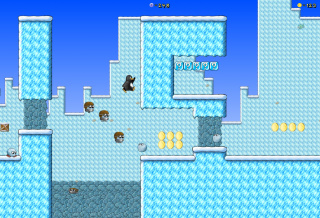SuperTux
| SuperTux | |
|---|---|
 SuperTux v0.6.0 | |
| Genres | Side-scrolling platform game |
| Latest release | 0.6.3 (Announcement) |
| Release date | December 23rd, 2021 |
| Platforms | Linux, Mac, Windows, FreeBSD, Haiku |
| Developers | Bill Kendrick (retired from project), Ingo Ruhnke, others |
| Code license | GPLv3[1] |
| Media license | GPL[2], CC BY-SA[3] |
| P. language | C++ |
| Library | SDL |
| Contribute | |
| SuperTux is a free game. This means that the source code is available to be studied, modified, and distributed. Most projects look for help with testing, documentation, graphics, etc., as well. | |
| supertux | |
| supertux | |
| supertux | |
| org.supertuxproject.SuperTux | |
| supertux | |
| games-arcade/supertux | |
| games-arcade/supertux | |
| supertux | |
| supertux | |
| supertux | |
| supertux | |
| supertux |
SuperTux is a 2D side-scrolling platform game featuring Tux the Linux penguin mascot, inspired by the Super Mario series.[4] It is programmed in C++.
SuperTux was originally created by Bill Kendrick. Ingo Ruhnke created many of the levels.
It is licensed under the GPLv3.[1]
Development[edit]
Among the members of the development team are:
Gameplay[edit]
In SuperTux, the player controls Tux, making him run around collecting power-ups, killing various enemies, and discovering new worlds, all for the purpose of rescuing his beloved Penny, who was captured by Nolok while Tux was distrated dancing on a picnic with her. The screen resolution is huge, allowing the player to see far ahead.
There are no lives. Instead, Tux simply respawns at the start of the level when he dies, unless he has touched the midpoint bell, in which case he'll respawn in the middle of the level and lose a few coins.
There are 2 main worlds, the Icy Island and Forest, along with many contributed worlds, such as the Halloween world. All worlds feature a worldmap, which is used to traverse across levels.
There are 5 powerups. Four of them use a special system where the more copies are collected of them, (without losing them) the better they become. For example, the more fireflowers are collected, the more fireballs can Tux shoot at once.
The Linux Game Tome's Game of the Month project helped improve the game in 2004.[5] A version of the game was included on OpenSource Game Power volume 1.